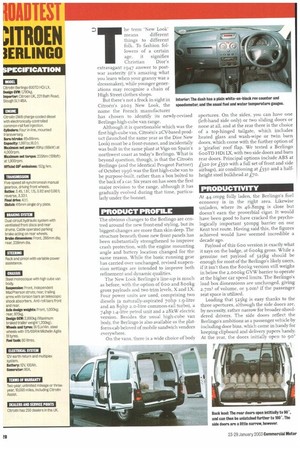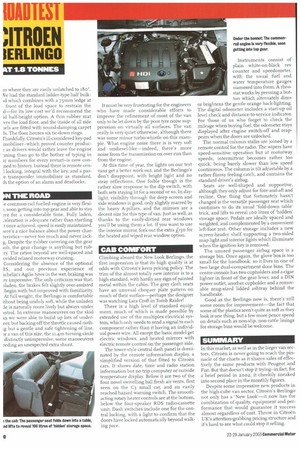he term 'New Look' means different things to different folk.
Page 28

Page 30

If you've noticed an error in this article please click here to report it so we can fix it.
To fashion followers of a certain age, it signifies Christian Dior's extravagant 1947 answer to postwar austerity (it's amazing what you learn when your granny was a dressmaker), while younger generations may recognise a chain of High Street clothes shops.
But there's not a frock in sight in Citroen's 2003 New Look, the name the French manufacturer has chosen to identify its newly-revised Berlingo high-cube van range.
Although it is questionable which was the first high-cube van, Citroen's 2CV-based product (launched the same year as the Dior New Look) must be a front-runner, and incidentally was built in the same plant at Vigo on Spain's northwest coast as today's Berlingo. What is beyond question, though, is that the Citroen Berlingo (and the identical Peugeot Partner) of October 1996 was the first high-cube van to be purpose-built, rather than a box bolted to the back of a car. Six years on has seen the first major revision to the range, although it has gradually evolved during that time, particularly under the bonnet.
PRODUCT PROFILE
The obvious changes to the Berlingo are centred around the new front-end styling, but its biggest changes are more than skin deep. The structure beneath those new front panels has been substantially strengthened to improve crash protection, with the engine mounting angle and battery location changed for the same reason. While the basic running gear has carried over unchanged, revised suspension settings are intended to improve both refinement and dynamic qualities.
The New Look Berlingo's line-up is much as before, with the option of Goo and 8 ookg gross payloads and two trim levels, X and LX. Four power units are used, comprising two diesels (a naturally-aspirated 7ohp and an 89hp 2.0-litre common-rail turbo), a 74hp 1.4-litre petrol unit and a 28kW electric version. Besides the usual high-cube van body, the Berlingo is also available as the platform-cab beloved of mobile sandwich vendors everywhere.
On the vans, there is a wide choice of body
apertures. On the sides, you can have one (left-hand side only) or two sliding doors or none at all, and at the rear there is the choice of a top-hinged tailgate, which includes heated glass and wash-wipe or twin barn doors, which come with the further option of a ‘girafon' roof flap. We tested a Berlingo GooTD HDi LX, with two side doors and barn rear doors. Principal options include ABS at £320 (or L'55o with a full set of front and side airbags), air conditioning at f55o and a halfheight steel bulkhead at ko.
PRODUCTIVITY
At 44.1mpg fully laden, the Berlingo's fuel economy is in the right area. Likewise unladen, where its 46.8mpg is close but doesn't earn the proverbial cigar. It would have been good to have cracked the psychologically important ompg barrier on our Kent test route. Having said this, the figures achieved would have seemed incredible a decade ago.
Payload of this Goo version is exactly what it says on the badge, at 600kg gross. While a genuine net payload of 525kg should be enough for most of the Berlingo's likely users, if it isn't then the 8 ookg version still weighs in below the 2, 000kg GVW barrier to operate at the higher car speed limits. The Berlingo's load box dimensions are unchanged, giving 2.7m3 of volume, or 3.om3 if the passenger seat space is utilised.
Loading that 525kg is easy thanks to the three apertures, although the side doors are, by necessity, rather narrow for broader-shouldered drivers, The side doors reflect the Berlingo's ambitions as a passenger vehicle by including door bins, which come in handy for keeping clipboard and delivery papers handy. At the rear, the doors initially open to 90°
m where they are easily unlatched to i8e. 71/e had the standard ladder-type half bulkid which combines with a 75mm ledge at front of the load space to restrain the d—for its low cost we'd recommend the id half-height option. A thin rubber mat ,ers the load floor, and the inside of all side leis are fitted with sound-damping carpet Is. The floor houses six tie-down rings. rhankfully, Citroen's ill-considered key-pad mobiliser-which proved counter producas drivers would rather leave the engine aning than go to the bother of typing in tr numbers for every restart-is now conned to history. Instead there is remote cen1 locking, integral with the key, and a pase transponder immobiliser as standard, th the option of an alarm and deadlocks.
N THE ROAD
le common-rail fuelled engine is very flexi! soon getting into top gear and able to stay !re for a considerable time. Fully laden, :eleration is adequate rather than startling .t once achieved, speed is easily maintained. iere's a nice balance about the power charteristics—never too much and never lackg. Despite the rubber covering on the gear lob, the gear change is anything but rubry. The ratios beyond are well-spaced and ovided relaxed motorway cruising.
Considering the absence of the optional BS, and our previous experience of ichelin's Agilis tyres in the wet, braking was ry impressive. The only criticism was that, iladen, the brakes felt slightly over-assisted begin with but improved with familiarity. At full weight, the Berlingo is comfortable ithout being unduly soft, while the unladen ie is naturally more lively but always under introl. In extreme manoeuvres on the skid m we were able to build up lots of undereer, but backing off the throttle caused nothg but a gentle and safe tightening of line. )r a van of this size, the 11.4m turning circle distinctly unimpressive, some manoeuvres !eding an unexpected extra shunt.
It must be very frustrating for the engineers who have made considerable efforts to improve the refinement of most of the van only to be let down by the poor tyre noise suppression on virtually all surfaces. The van really is very quiet otherwise, although there was some minor turbo-whistle on this example. What engine noise there is is very soft and undiesel-like—indeed, there's more noise from the transmission on over-run than from the engine.
At this time of year, the lights on our test vans get a better work out, and the Berlingo's don't disappoint, with bright light and no stray reflections. One foible though is the rather slow response to the dip switch, with both sets staying lit for a second or so. In daylight, visibility through the deep screen and side windows is good, only slightly marred by the heavy A-pillars, and the mirrors are a decent size for this type of van. Just as well, as thanks to the easily-dirtied rear windows you'll be using them a lot. If you want to use the interior mirror, fork out the extra £15o for the heated and wiped rear window option.
CAB COMFORT
Climbing aboard the New Look Berlingo, the first impression is that its high quality is at odds with Citroen's keen pricing policy. The trim of the almost totally new interior is to a high standard, with hardly any sign of painted metal within the cabin. The grey doth seats have an unusual chequer plate pattern on much of their surface—perhaps the designer was watching bra Croft in Tomb Raider!
There is a high level of standard equipment, much of which is made possible by extended use of the multiplex electrical system, which only needs to send a signal to each component rather than it having an individual power wire. All except the basic model get electric windows, and heated mirrors with electric remote control on the passenger side The tower-style central dash panel is dominated by the remote information display, a simplified version of that fitted to Citroen cars. It shows date, time and radio station information but no trip computer or outside temperature display. Below it are two of the four novel swivelling ball fresh air vents, first seen on the C3 small car, and an easily reached hazard warning switch. The smoothacting rotary heater controls are at the bottom, below the four-speaker R DS radio-cassette unit. Dash switches include one for the central locking, with a light to confirm that the doors have locked automatically beyond walking pace.
Instruments consist of plain white-on-black rev counter and speedometer, with the usual fuel and water temperature gauges siamesed into them. A rheostat works by pressing a button which alternately dims or brightens the gentle orange back-lighting. The digital odometer includes a start-up oil level check and distance-to-service indicator. For those of us who forget to check the mileage when buying fuel, the odometer stays displayed after engine switch-off and reappears when the doors are unlocked.
The normal column stalks are joined by a remote control for the radio. The wipers have speed-sensitive operation but at motorway speeds, intermittent becomes rather too quick, being barely slower than low speed continuous. The column is tilt adjustable by a rather flimsy feeling catch, and contains the standard driver's airbag.
Seats are well-shaped and supportive, although they only adjust for fore-and-aft and recline. One thing that fortunately hasn't changed is the versatile passenger seat which continues to do its usual 'fold-down table' trick, and lifts to reveal io o litres of 'hidden' storage space. Pedals are ideally spaced and weighted, and complemented by a convenient left-foot rest. Other storage includes a new screen-header shelf supporting a two-sided map light and interior lights which illuminate when the ignition key is removed.
The unused passenger airbag space is a storage bin. Once again, the glove box is too small for the handbook, so it lives in one of two large dual-compartment door bins. The centre console has two cupholders and a cigar lighter in front of the gear lever, and a DIN power outlet, another cupholder and a removable mug-sized lidded ashtray behind the handbrake.
Good as the Berlingo now is, there's still some room for improvement—the fact that some of the plastics aren't quite as soft as they look is one thing, but a few more pence spend on details such as non-slip, non-rattle linings for storage bins would be welcome.
SUMMARY
In this market, as well as in the larger van sectors, Citroen is never going to reach the pinnacle of the charts as it shares sales of effectively the same products with Peugeot and Fiat. But that doesn't stop it trying-in fact, for a brief period in 2002, it cheekily sneaked into second place in the monthly figures,
Despite some impressive new products in the high-cube van sector, Citroen's Berlingo not only has a 'New Look'—it now has the combination of quality, equipment and performance that would guarantee it success almost regardless of cost. Throw in Citroen UK's attention-grabbing pricing structure and it's hard to see what could stop it selling.




























































































































































